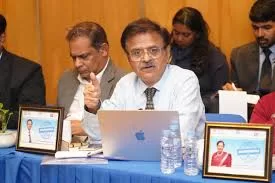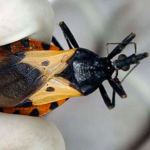Situation at a glance
Description of the situation
Between early June and 15 August 2024, the Ministry of Health and Family Welfare of the Government of India reported 245 cases of AES including 82 deaths (CFR 33%). A total of 43 districts in India are currently reporting AES cases. Cases are sporadically present across various districts as in previous outbreaks. Notably, there is a rise in CHPV outbreaks every four to five years in Gujarat state.
Of the total 245 AES cases reported, CHPV has been confirmed in 64 cases through immunoglobulin M enzyme-linked immunosorbent assay (IgM ELISA) or reverse transcription polymerase chain reaction (RT-PCR). Of the 64 confirmed cases, 61 cases have been reported from Gujarat State and three from Rajasthan State.
A declining trend in the number of new cases of AES has been observed daily since 19 July 2024.[1].[2]
To date, no human-to-human transmission has been reported. In 2003, a large outbreak of AES was reported in Andhra Pradesh, with 329 suspected cases and 183 deaths; a study suggests that this was due to CHPV.[2]
Epidemiology
CHPV is a member of the Rhabdoviridae family and is known to cause sporadic cases and outbreaks of AES in western, central and southern parts of India, especially during the monsoon season. It is transmitted by vectors such as sandflies, mosquitoes and ticks. Phlebotomus papatasi (a sandfly) is reported to be the vector of CHPV disease in Gujarat. CHPV can cause high case fatality ratios, ranging from 56% to 75% as reported during previous outbreaks in India. The disease affects mostly children under 15 years and can present with a febrile illness that may progress to convulsions, coma, and in some cases, death. In children, it can lead to high mortality within 48 to 72 hours of symptoms onset, typically presenting with AES.
CHPV has not been detected in other countries; however, according to a study [3], it may be present in other countries in Asia and Africa. The sandfly vectors are abundant in the South-East Asia Region. There is no evidence that this virus has been detected among those travelling from India to other countries.
Public health response
The Ministry of Health and Family Welfare have taken the following prevention and control measures:
- Deployment of National Joint Outbreak Response Team (NJORT): A specialized team has been dispatched to assist the Gujarat state government in implementing public health measures and conducting detailed epidemiological investigations.
- Vector control measures: Comprehensive insecticidal spraying and fumigation are being carried out to control vectors, such as sandflies, that transmit the virus.
- Health and awareness campaigns: Initiatives are underway to provide information to the public and medical personnel about the virus, its symptoms, and preventive measures.
- Research and monitoring: The Gujarat Biotechnology Research Centre (GBRC) is actively researching to identify other viruses causing encephalitis and is closely monitoring the situation.
- Advisories and coordination: Joint advisories from the National Centre for Disease Control (NCDC) and the National Centre for Vector Borne Diseases Control (NCVBDC) are being issued to guide neighboring states reporting cases of AES.
The State authorities have taken the following public health response actions.
- Gujarat: the state has undertaken various public health measures such as insecticidal spray for vector control, community engagement, sensitization of medical personnel and timely referral of cases to designated health facilities.
- Rajasthan: the health department has issued a detailed advisory to health professionals to take precautions regarding CHPV, after a three-year-old boy tested positive in the Dungarpur district. The department has also issued an alert in the Gujarat-bordering districts of Udaipur, Dungarpur, Banswara, Sirohi and Jalore.
Support provided by WHO
WHO works closely with the Ministry of Health and Family Welfare (MoHFW), as a member of the Joint Monitoring Group, under the Director General of Health Services. The Group oversees the response efforts, and provides strategic guidance to ensure a coordinated and effective response. A WHO field team is actively engaged with local authorities, discussing and sharing technical information. Additionally, the WHO field team maintains constant communication with key local health officials and clinicians at health facilities to closely monitor the situation, and is supporting verification of signals generated from the event-based surveillance.
WHO risk assessment
Although previous outbreaks have been reported in India, this outbreak is considered the largest in the past 20 years. While authorities are making efforts to control the transmission of CHPV, further transmission of CHPV is possible in the coming weeks, considering the favorable conditions for vector populations during the monsoon season in affected areas.
CHPV infection causes a rapid symptom onset and a high case-fatality ratio (56-75%). There is no specific treatment or vaccine available, and management is symptomatic; timely referral of suspected AES cases to designated facilities can improve outcomes. CHPV infection can cause epidemics with a substantial demand on public health systems, including surveillance, case management, infection prevention and control, and laboratory capacity to diagnose CHPV infection.
WHO assessed the risk as moderate at the national level based on above considerations. The risk assessment will be reviewed as the situation of the outbreak evolves.
WHO advice
Vector control, and protection against bites of sandflies, mosquitos, and ticks, are key measures to prevent transmission of CHPV. Poor housing and domestic sanitary conditions (lack of waste management or open sewerage) may increase sandfly breeding and resting sites, as well as vector access to humans.
Although there is no specific antiviral treatment and no approved vaccines, early access to care and supportive treatment can improve disease outcome. It is important to ensure that basic supportive care capacities are in place at primary and district health care facilities to manage cases before referral following the protocol (such as standard encephalitis management protocol). As such, increasing frontline health care worker knowledge of symptomology and referral pathways to designated facilities is key for early detection and access to appropriate care.
Surveillance efforts should be enhanced in high-risk areas, focusing on people at risks, such as children younger than 15 years of age presenting with acute onset of fever and central nervous system symptoms.
It is important to ensure that laboratory diagnostic capacities are available, including for timely collection, transport and testing of serum and cerebrospinal fluid samples for serological and virological investigation at a referral laboratory.
Risk communication and community engagement is critical to ensure effective vector control activities. Awareness and knowledge of potential risks, prevention methods, symptoms and when to seek testing and treatment should be enhanced among communities at risk.
WHO does not recommend any general travel or trade restrictions based on the available information.
Further information
- World Health Organization. (2024). Operational-manual on indoor residual spraying: Control of vectors of malaria, Aedes-borne diseases, Chagas disease, leishmaniases and lymphatic filariasis. https://www.who.int/publications/i/item/9789240083998
- Bhatt, P. N., & Rodrigues, F. M. (1970). Chandipura:A new arbovirus isolated in India from patients with febrile illness. CABI Databases. https://www.cabidigitallibrary.org/doi/full/10.5555/19701000635
- Chadha, M. S., Arankalle, V. A., Jadi,R. S., Joshi, M. V., Thakare, J. P., Mahadev, P. V. M., & Mishra, A. C.(2005). An outbreak of Chandipura virus encephalitis in the eastern districts of Gujarat State, India. American Journal of Tropical Medicine & Hygiene,73(3), Article 3. http://www.ajtmh.org/cgi/content/abstract/73/3/566
- Sudeep, A. B., Gurav, Y. K., & Bondre, V. P.(2016). Changing clinical scenario in Chandipura virus infection. https://pubmed.ncbi.nlm.nih.gov/27748295/
[1] https://pib.gov.in/PressReleaseIframePage.aspx?PRID=2039935
[3] Sapkal, G. N., Sawant, P. M., & Mourya, D. T. (2018). Suppl-2, M2: Chandipura Viral Encephalitis: A Brief Review. The Open Virology Journal, 12, 44. https://www.ncbi.nlm.nih.gov/pmc/articles/PMC6142667/
Citable reference: World Health Organization (23 August 2024). Disease Outbreak News; Acute encephalitis syndrome due to Chandipura virus-India. Available at: http://www.who.int/emergencies/disease-outbreak-news/item/2024-DON529












